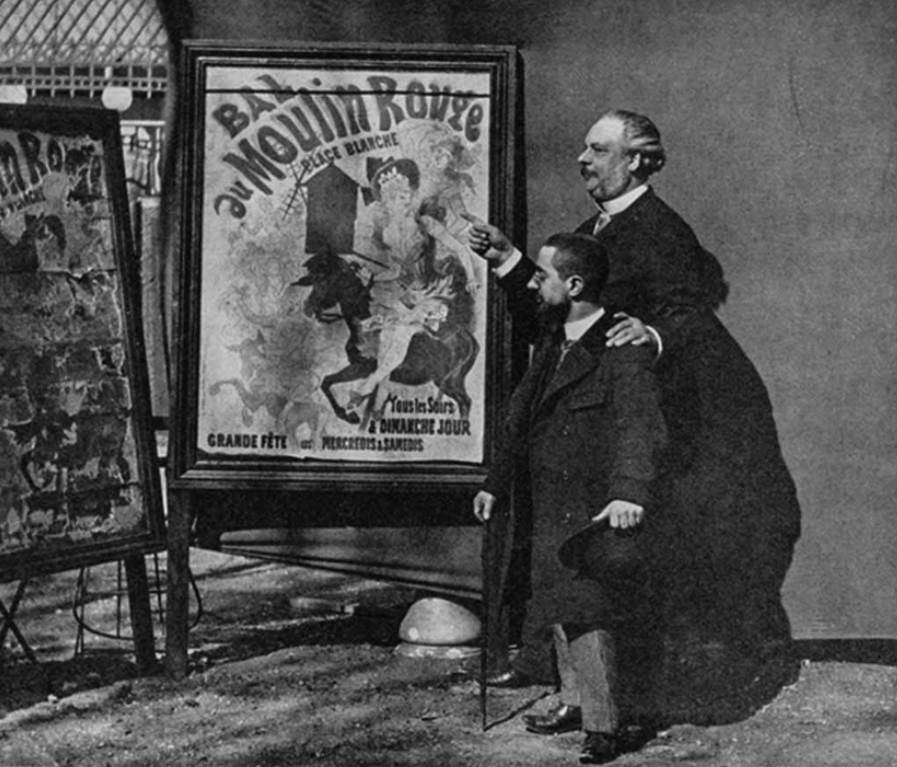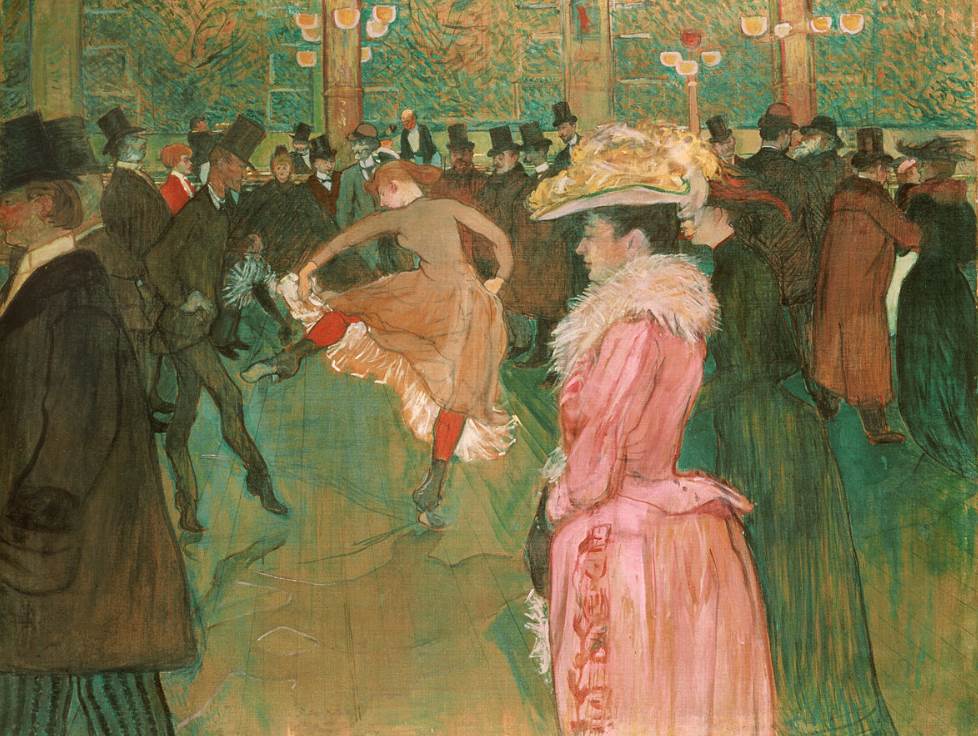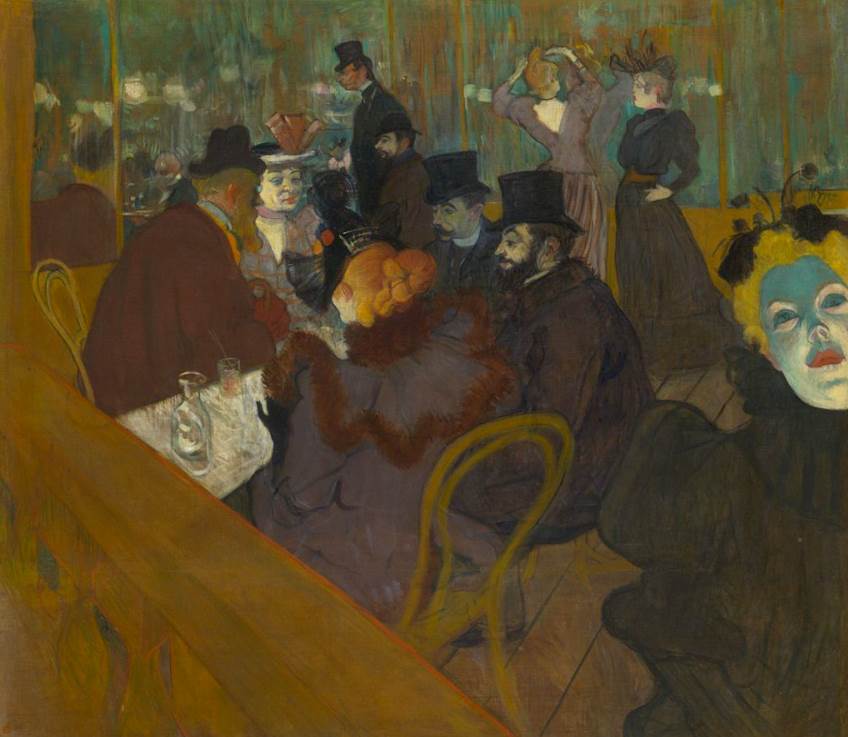If you want to know what the nightlife in Paris in the late 19th century looked like, then the oeuvre of his famous French artists is a great place to start.
Henri de Toulouse-Lautrec (1864-1901) is most famously known as an Art Nouveau artist who designed advertisements for magazines and popular nightclubs in Paris.
The prolific artist also produced 737 paintings, many in the Post-Impressionist style that was popular at the time.
In this article, you’ll discover some of the most interesting facts about At The Moulin Rouge: The Dance by Henri de Toulouse-Lautrec, a painting that provides a glimpse of contemporary Parisian nightlife.
1. It was completed shortly after the Moulin Rouge opened its doors
One of the most famous cabarets in the world opened its doors for the first time in 1889, and Henri de Toulouse-Lautrec was waiting in line to get in.
He was already a full-blown alcoholic at the time who couldn’t resist the Parisian nightlife and visiting brothels. These two elements are recurring subjects in his oeuvre.
The cabaret in Paris is located near Montmartre in the Pigalle district in the northern part of the city. It was an instant success when it opened and it still exists today.

2. It depicts the interior of the cabaret and two dancers dancing the can-can
Henri de Toulouse-Lautrec was born into an aristocratic family but a rare illness and the fact that he broke both his legs made him much shorter than others as an adult.
He started painting as an adolescent and he moved to Paris in the early 1880s to study with the renowned French painter Léon Bonnat (1833-1922).
This is how he ended up in a studio in Montmartre where he met countless other aspiring artists. He also immersed himself in Parisian nightlife and indulged in heavy drinking.
This painting depicts the interior of the Moulin Rouge shortly after its opened its doors. We can see the clientele and two dancers on the dance floor during a break on stage.

3. The male dancer has been identified as a famous French can-can dancer
The cabaret became world-famous for the performance of the can-can dance, known in France as the “Chahut.”
The can-can was already popular since the 1840s but the Moulin Rouge became synonymous with this high-energy dance performance.
The artist wrote a note on the back of the painting saying:
The training of the new girls by Valentin ‘the Boneless.
This allows us to identify the male dancer as “Valentin le Désossé” or “Valentin the Boneless,” the stage name of Jacques Renaudin (1843-1926).
He earned this nickname because of the fact that he was extremely flexible, a feature he used to become one of the most popular dancers of the 1890s.

4. It was the second of several paintings by the artist which depicts the Moulin Rouge
Henri de Toulouse-Lautrec wasn’t merely a customer at the Moulin Rouge (and because of his heavy drinking sessions, a good one as well).
He also played a major role in the popularity of this cabaret during the first decade of its existence. He not only produced several oil paintings but also designed posters to promote the venue.
At the Moulin Rouge: The Dance was the second in a series of oil paintings that depict the interior of the dance hall and some of its most significant people.
It’s also one of the most famous ones together with the work titled “At the Moulin Rouge,” a painting that is part of the collection of the Art Institute of Chicago.

5. Many people in the background were people who the artist knew personally
The foreground of the painting is dominated by an unidentified aristocratic lady wearing a distinctive pink dress and yellow hat.
The background is full of peculiar figures, including men whose face has turned green and aristocratic gentlemen wearing tall hats.
Some of the people have been identified as:
- The Irish poet William Butler Yeats (1865-1939)
- The owners of the Moulin Rouge, Charles Zidler (1831-1897) and Joseph Oller (1839-1922)
- The artist’s father Alphonse Charles Comte de Toulouse-Lautrec-Monfa (1838–1913)

6. The painting once hung above the bar of the cabaret it depicts
The painting was received well and one of the owners of the Moulin Rouge, Joseph Oller, purchased the painting and hung it above the bar.
Luckily it didn’t stay there because the original version of the Moulin Rouge burned to the ground in 1915, including the red windmill that made it so famous.
It took a decade before the new venue was established and the cabaret opened its doors once again in 1925, right in the middle of the Roaring Twenties.

7. How big is At The Moulin Rouge: The Dance by Henri de Toulous-Lautrec
This painting in the series that depicts the Parisian dance hall is not only one of the most famous, but it’s also the largest one and one of the largest that Toulouse-Lautrec ever produced.
At the Moulin Rouge: The Dance is an oil on canvas painting that has dimensions of 115.6 × 149.9 centimeters (45.51 × 59.02 inches).
8. Where is the painting located today?
The painting hung at the Moulin Rouge between 1890 and 1893 before it was acquired by a Parisian art dealer.
The painting was sold to art collector and philanthropist Henry P. McIlhenny (1910-1986), a man who became the chairman of the Philadelphia Museum of Art.
He bequeathed his entire collection to this museum in Philadelphia in 1986 and today, you can admire this masterpiece at this popular museum.



